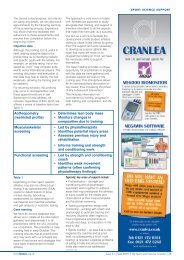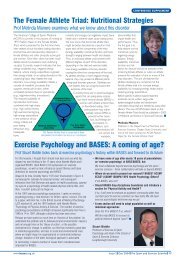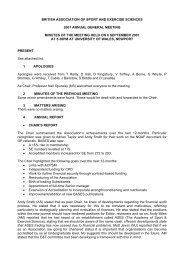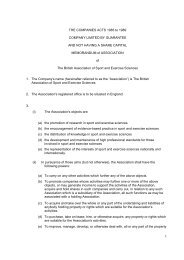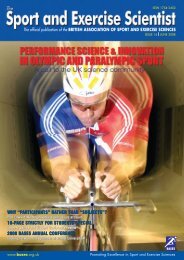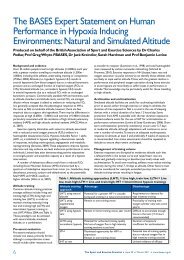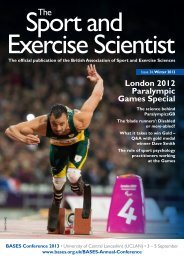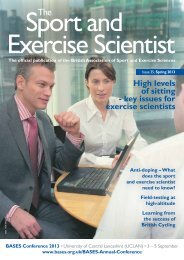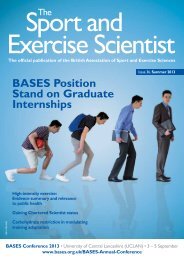Issue 31 Spring 2012 - Bases
Issue 31 Spring 2012 - Bases
Issue 31 Spring 2012 - Bases
You also want an ePaper? Increase the reach of your titles
YUMPU automatically turns print PDFs into web optimized ePapers that Google loves.
Case study<br />
The interdisciplinary approach to the<br />
management of chronic knee pain in the<br />
elite athlete – a case study<br />
Experts from the Intensive Rehabilitation Unit (IRU) based at Bisham Abbey National Sports Centre provide<br />
an insight into the interdisciplinary approach taken to providing optimal injury rehabilitation to elite athletes.<br />
Introduction<br />
The performance of an athlete is supported by input from a<br />
large number of professionals from a wide range of disciplines,<br />
and the recovery of an athlete from injury is no different. The<br />
effectiveness of interaction between the professionals involved in<br />
an athlete’s rehabilitation can make the difference between optimal<br />
and delayed recovery. A truly interdisciplinary approach has been<br />
shown to optimise medical rehabilitation when compared to that<br />
of a multidisciplinary team (Korner, 2010). By identifying objective<br />
markers, the effectiveness of the team in improving function and<br />
effecting change in the injured site can be monitored.<br />
History<br />
This case study involves a 21 year old male, elite-level weightlifter<br />
with severe left anterior knee pain, which came on whilst squatting<br />
an empty bar following a period of rest for another injury. A<br />
diagnostic ultrasound scan showed collagen degeneration and he<br />
underwent plasma rich platelet (PRP) injections at the left patella<br />
tendon insertion and proximal patella. His pain improved, as did<br />
the appearance of the tendon on ultrasound, and he commenced<br />
an eccentric squat programme for six minutes each day, which was<br />
governed by a visual analogue scale (VAS) with a pain score of 4-5<br />
out of 10 during exercise.<br />
His pain returned and he underwent a steroid injection to<br />
the tibial tuberosity three weeks before his admission to the IRU.<br />
Once again there was improvement in his pain but he continued to<br />
complain of anterior knee pain, which was aggravated by training<br />
and on stairs. The weightlifting support team subsequently referred<br />
this athlete to the IRU for a one-week block of investigation and<br />
intensive treatment as part of his overall rehabilitation strategy.<br />
Clinical examination<br />
On assessment the athlete presented with reduced muscle tone<br />
and definition around his left knee compared to the right, as well<br />
as reduced strength on manual muscle testing. He had full range of<br />
movement of his knee with no pain or tenderness but significant<br />
laxity of the medial collateral and anterior cruciate ligaments, with<br />
excessive tibial rotation bilaterally, worse on the left. Around the<br />
pelvis he had poor gluteal function on the left with poor control of<br />
his sacroiliac joint; radiculopathy signs at L2-L4; paraspinal muscle<br />
tenderness and stiffness of his thoracic spine. Of relevance was a<br />
history of three previous bone stress injuries in the right tibia (see<br />
Table 1).<br />
Management<br />
The management of this athlete necessitated an interdisciplinary<br />
approach that involved integration of medical, physiotherapy,<br />
psychology, nutrition, strength and conditioning and physiology<br />
support. The physiotherapy approach involved the integration of<br />
two theoretical models. The application of this intervention was<br />
based on objective and repeatable clinical markers.<br />
The neuropathic pain and dysfunction model (Gunn, 2002)<br />
This model looks at disturbed function and super sensitivity in<br />
the peripheral nervous system, which is often apparent in chronic<br />
conditions such as this (Loeser, 2001). His key clinical markers<br />
of prone hip extension off the end of a plinth showed very poor<br />
inner range gluteal strength with excessive trunk rotation at<br />
L2/3 lumbar levels. This test reproduced his knee pain. Using this<br />
marker, treatment focused on the lumbar spine using intensive<br />
intramuscular stimulation to impact on the referred pain. Dry<br />
needling, a form of acupuncture was also performed on the<br />
quadratus lumborum, iliocostalis and quadriceps muscles. Following<br />
this treatment the hip extension test improved and his knee pain<br />
decreased.<br />
The load transfer model<br />
The next element of clinical intervention involved addressing<br />
the athlete’s load transfer dysfunction. The fundamentals of his<br />
kinetic chain were examined and objective markers obtained.<br />
Scientific measures are essential in underpinning clinical decisions.<br />
Table 1 shows those of relevance in this case. All of these factors<br />
contributed to a decreased ability to transfer load effectively, placing<br />
the left knee under greater load and leading to pathological changes.<br />
A programme was put in place to address these dysfunctions (see<br />
Table 2) and was performed daily as part of preparation before<br />
strength training.<br />
Table 1. Relevant clinical findings<br />
Anterior Posterior proprioceptive deficit on sway test<br />
External rotation left hip restricted greater than 50%<br />
Extension in standing shear at L2/3<br />
Stiff lumbar flexion and thoracic stiffness<br />
Side holds showed a 47% discrepancy – left greater than right<br />
Table 2. Rehabilitation programme<br />
Hip and trunk programme<br />
Prone bench gluteal extension (3 x 10 reps)<br />
Bird dog with theraband alternate arm /leg extensions (3 x 10 reps)<br />
Static theraband side step outs (3 x 12 reps)<br />
Wide arm pushups (3 x 10 reps)<br />
Standing theraband leg pulses (3 x 12 reps)<br />
Gluteal and oblique force couple in side lying (3 x 8 reps)<br />
Knee stability drill<br />
Single leg anterior – posterior direction proprioception drills (3 x 60 sec)<br />
Reverse lunge (3 x 8 reps)<br />
Assisted squat (3 x 10 reps)<br />
Load transfer capacity was greatly assisted by targeted manual<br />
mobilisation and self mobilisation to the thoracic spine. Pre- and<br />
post-exercise dynamic thoracic extension and rotation exercises<br />
were completed. Soft tissue massage, especially deep facial release<br />
to the spiral line and superficial back line was performed by the soft<br />
tissue therapist. Specific points to mid thoracic area/tensor fascia<br />
lata and abdominal aponeuroses made a significant impact in trunk<br />
control strategies.<br />
6 The Sport and Exercise Scientist n <strong>Issue</strong> <strong>31</strong> n <strong>Spring</strong> <strong>2012</strong> n www.bases.org.uk



